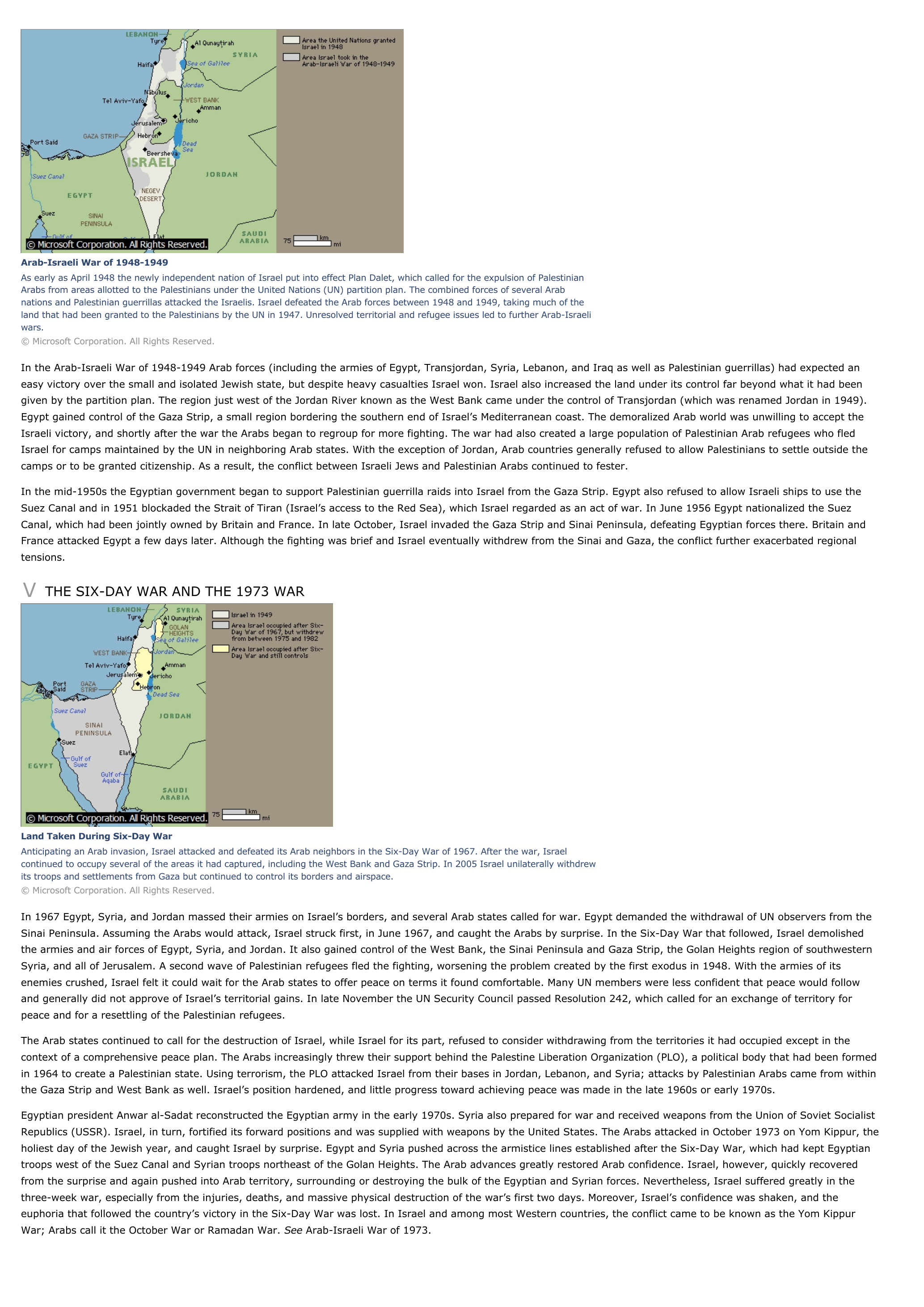Arab-Israeli Conflict - history.
Publié le 26/05/2013

Extrait du document
«
Arab-Israeli War of 1948-1949As early as April 1948 the newly independent nation of Israel put into effect Plan Dalet, which called for the expulsion of PalestinianArabs from areas allotted to the Palestinians under the United Nations (UN) partition plan.
The combined forces of several Arabnations and Palestinian guerrillas attacked the Israelis.
Israel defeated the Arab forces between 1948 and 1949, taking much of theland that had been granted to the Palestinians by the UN in 1947.
Unresolved territorial and refugee issues led to further Arab-Israeliwars.© Microsoft Corporation.
All Rights Reserved.
In the Arab-Israeli War of 1948-1949 Arab forces (including the armies of Egypt, Transjordan, Syria, Lebanon, and Iraq as well as Palestinian guerrillas) had expected aneasy victory over the small and isolated Jewish state, but despite heavy casualties Israel won.
Israel also increased the land under its control far beyond what it had beengiven by the partition plan.
The region just west of the Jordan River known as the West Bank came under the control of Transjordan (which was renamed Jordan in 1949).Egypt gained control of the Gaza Strip, a small region bordering the southern end of Israel’s Mediterranean coast.
The demoralized Arab world was unwilling to accept theIsraeli victory, and shortly after the war the Arabs began to regroup for more fighting.
The war had also created a large population of Palestinian Arab refugees who fledIsrael for camps maintained by the UN in neighboring Arab states.
With the exception of Jordan, Arab countries generally refused to allow Palestinians to settle outside thecamps or to be granted citizenship.
As a result, the conflict between Israeli Jews and Palestinian Arabs continued to fester.
In the mid-1950s the Egyptian government began to support Palestinian guerrilla raids into Israel from the Gaza Strip.
Egypt also refused to allow Israeli ships to use theSuez Canal and in 1951 blockaded the Strait of Tiran (Israel’s access to the Red Sea), which Israel regarded as an act of war.
In June 1956 Egypt nationalized the SuezCanal, which had been jointly owned by Britain and France.
In late October, Israel invaded the Gaza Strip and Sinai Peninsula, defeating Egyptian forces there.
Britain andFrance attacked Egypt a few days later.
Although the fighting was brief and Israel eventually withdrew from the Sinai and Gaza, the conflict further exacerbated regionaltensions.
V THE SIX-DAY WAR AND THE 1973 WAR
Land Taken During Six-Day WarAnticipating an Arab invasion, Israel attacked and defeated its Arab neighbors in the Six-Day War of 1967.
After the war, Israelcontinued to occupy several of the areas it had captured, including the West Bank and Gaza Strip.
In 2005 Israel unilaterally withdrewits troops and settlements from Gaza but continued to control its borders and airspace.© Microsoft Corporation.
All Rights Reserved.
In 1967 Egypt, Syria, and Jordan massed their armies on Israel’s borders, and several Arab states called for war.
Egypt demanded the withdrawal of UN observers from theSinai Peninsula. Assuming the Arabs would attack, Israel struck first, in June 1967, and caught the Arabs by surprise.
In the Six-Day War that followed, Israel demolished the armies and air forces of Egypt, Syria, and Jordan.
It also gained control of the West Bank, the Sinai Peninsula and Gaza Strip, the Golan Heights region of southwesternSyria, and all of Jerusalem.
A second wave of Palestinian refugees fled the fighting, worsening the problem created by the first exodus in 1948.
With the armies of itsenemies crushed, Israel felt it could wait for the Arab states to offer peace on terms it found comfortable.
Many UN members were less confident that peace would followand generally did not approve of Israel’s territorial gains.
In late November the UN Security Council passed Resolution 242, which called for an exchange of territory forpeace and for a resettling of the Palestinian refugees.
The Arab states continued to call for the destruction of Israel, while Israel for its part, refused to consider withdrawing from the territories it had occupied except in thecontext of a comprehensive peace plan.
The Arabs increasingly threw their support behind the Palestine Liberation Organization (PLO), a political body that had been formedin 1964 to create a Palestinian state.
Using terrorism, the PLO attacked Israel from their bases in Jordan, Lebanon, and Syria; attacks by Palestinian Arabs came from withinthe Gaza Strip and West Bank as well.
Israel’s position hardened, and little progress toward achieving peace was made in the late 1960s or early 1970s.
Egyptian president Anwar al-Sadat reconstructed the Egyptian army in the early 1970s.
Syria also prepared for war and received weapons from the Union of Soviet SocialistRepublics (USSR).
Israel, in turn, fortified its forward positions and was supplied with weapons by the United States.
The Arabs attacked in October 1973 on Yom Kippur, theholiest day of the Jewish year, and caught Israel by surprise.
Egypt and Syria pushed across the armistice lines established after the Six-Day War, which had kept Egyptiantroops west of the Suez Canal and Syrian troops northeast of the Golan Heights.
The Arab advances greatly restored Arab confidence.
Israel, however, quickly recoveredfrom the surprise and again pushed into Arab territory, surrounding or destroying the bulk of the Egyptian and Syrian forces.
Nevertheless, Israel suffered greatly in thethree-week war, especially from the injuries, deaths, and massive physical destruction of the war’s first two days.
Moreover, Israel’s confidence was shaken, and theeuphoria that followed the country’s victory in the Six-Day War was lost.
In Israel and among most Western countries, the conflict came to be known as the Yom KippurWar; Arabs call it the October War or Ramadan War.
See Arab-Israeli War of 1973..
»
↓↓↓ APERÇU DU DOCUMENT ↓↓↓
Liens utiles
- Arab-Israeli Conflict - History.
- Arab-Israeli Conflict.
- Ideology and Rationality in the History of the Life Sciences
- HISTOIRE DU RÈGNE DE L'EMPEREUR CHARLES-QUINT [The History of the Reign of the Emperor Charles V].
- HISTOIRE DU MONDE [History of the World].





